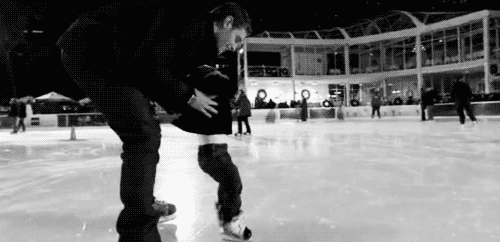Figure skating is a mixture of art and athleticism. No other sport combines the elegance with the danger of complex triple jumps, spiral sequences, lifts, and throws at thrilling speeds. Figure skating is a perfect example that you can apply to physics in everyday life. Here’s a perfect chance to watch examples of basic scientific concepts such as friction, angular momentum and projectile motion.
The difference between dancing on a floor and skating on ice is the lack of friction. Compared to a wooden floor, ice has much less friction. Smooth ice provides very little resistance against objects, like ice skates, being dragged across its surface. Ice skates are designed to take advantage of this with their grooved blades that are only one-eighth of an inch thick, because of the minimal contact with an already low friction surface, skaters find little resistance as they slide against the ice and can glide smoothly. Friction is a force that opposes the sliding of two surfaces across one another. Friction arises because the molecules on both surfaces bond with each other, and resist when the surfaces try to move away and break the bonds. The more rough and jagged something is, the more easily more of its molecules will come into contact with molecules on the surface it touches, and thus the greater force of friction will exert. The general low level of friction on ice allows a skater to glide along the surface smoothly without friction stopping the motion as soon as it’s begun. In order to reduce friction between the ice and the skater, it is important to keep the blades sharpened.
Issac Newton’s first law of motion, which explains an object in motion tends to stay in motion unless acted on by a force. This is the reason why ice skaters whose motion isn’t being acted on by a powerful enough force of friction, tend to stay in motion, unless they use force to stop themselves. Skating would be impossible if there were no friction at all on the ice. It is the friction between the skate and the ice when a skater pushes off that starts the motion to begin with. Friction also allows a skater to stop.
The coefficient of friction U is the ratio of the force of friction(Ff) to the normal force(Fn).The equation is Uf = Ff/Fn. Coefficient of kinetic friction(Uk) is the ratio of kinetic friction to the normal force. The corresponding equation is Uk=Fk/Fn. We will only need to use this equation (Uk=Fk/Fn) to solve the question below.
Question) Meryl glides across the ice on her skates, which have steel blades. She is 40kg. What is the magnitude of the force of friction acting on Meryl? (Uk = 0.01 - steel on ice)


No comments:
Post a Comment